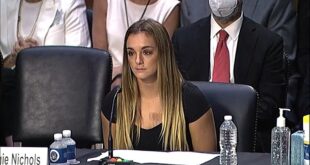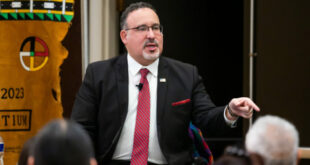By Matt Vasilogambros, Pennsylvania Capital-Star
Shortly after the U.S. Supreme Court ruling last month that expanded the right to carry firearms outside the home, gun rights activist Andrew Namiki Roberts rushed to the Honolulu Police Department to apply for four permits to carry handguns in public. He was fourth in line, surrounded by excited Hawaii gun owners who felt vindicated in their crusade for greater firearm access.
The high court’s June 23 decision struck down a New York law that required people to show a specific need to carry a firearm in public. And it means similar laws in five other states, including Hawaii, are now unconstitutional. Roberts likely won’t receive his gun permits until the legislature amends state law or the state attorney general issues new guidance, but he is eager to carry a gun outside his home because he is convinced it will make him safer.
“We finally have our Second Amendment rights affirmed,” said Roberts, who is director of the Hawaii Firearms Coalition.
Elated gun rights advocates say the Supreme Court’s decision in New York State Rifle and Pistol Association v. Bruen has opened the door to overturning many other state gun restrictions.
Gun safety advocates, however, emphasize that the court’s ruling was limited in scope and still allows states to regulate types of firearms, where people can carry firearms and the permitting process, including requirements for background checks and training. Democratic lawmakers in some of the states affected by the Supreme Court decision already have passed new firearm restrictions that they hope will survive judicial scrutiny.
The New York law, which had been on the books for more than a century, required residents to demonstrate a “proper cause” for carrying a concealed handgun in public for self-defense. Not only did the court strike down this law, finding it was applied unevenly, but it also established a new legal test. Gun laws now must be judged based on the “text, history and tradition” of the Second Amendment: What did the amendment mean to the founders, where did they think the right to bear arms originated, and how did they apply it?
In the majority opinion, Justice Clarence Thomas wrote that the Second Amendment often has been treated like a second-class right.
“We know of no other constitutional right that an individual may exercise only after demonstrating to government officers some special need,” he wrote.
The ruling fundamentally changes the legal landscape for gun laws, said Hannah Hill, director of research and policy at the National Foundation for Gun Rights, which filed a brief in the case. Gun rights advocates now can “go on the offense,” Hill said. She hopes the “text, history and tradition” test eventually will lead to a day when people in every state can carry firearms without a permit.
“This is going to have massive implications,” Hill said. “It’s a radical test, and if applied accurately it will have radical results. A lot of gun laws will not be able to withstand Second Amendment scrutiny.”
This is the first major gun case taken up by the Supreme Court since Heller v. District of Columbia in 2008, in which the court established that Americans have the right to keep guns in their homes. The court, however, made it clear in that ruling that states could regulate gun ownership and where people could carry guns.
U.S. House panel presses gun makers to testify before Congress
Gun rights advocates’ excitement over this latest ruling is justified, said Darrell Miller, a professor at Duke University School of Law. There will be a wave of new litigation, he said.
“We can fully expect that gun rights advocates will use the majority opinion and reasoning to challenge not just licensing rules, but every single regulation on the book without clear historical backing,” Miller said.
Gun safety advocates argue the ruling in the New York case will exacerbate the epidemic of gun violence in the United States—a crisis in full view this week when a man killed seven people and injured more than 30 at a Fourth of July parade in Highland Park, Illinois, an affluent suburb north of Chicago.
After Monday’s shooting, Illinois Democratic Gov. J.B. Pritzker called gun violence a “uniquely American plague,” and rejected the notion that the right to own and carry high-powered weapons has historical backing.
“Our founders carried muskets, not assault weapons,” Pritzker said, “and I don’t think a single one of them would have said that you have a constitutional right to an assault weapon with a high-capacity magazine, or that that is more important than the right of the people who attended this parade today to live.”
When gun safety advocate and lawyer Josh Horwitz first saw the Supreme Court decision, he felt “pure outrage.” Horwitz, the co-director of the Center for Gun Violence Solutions at Johns Hopkins University, called the “text, history and tradition” test unworkable and unnecessary. The court, he said, could have struck down New York’s law without inventing a test that invites a “deluge of litigation.”
After mass shootings, state lawmakers nationwide weigh body armor bans
“It just smacked of no sound reason,” Horwitz said. “Are courts going to have to employ historians now? Are the rules of the road governed exclusively by history from 1791? What happened is just the worst possible outcome.”
In California, Hawaii, Maryland, Massachusetts, New Jersey and New York, the Supreme Court’s decision invalidates laws requiring permit applicants to prove they have a special need to carry a concealed firearm.
However, Democratic lawmakers in those states say the ruling leaves them room to tighten laws governing the sorts of firearms and ammunition people can use and where people can carry those guns.
Just over a week after the ruling, New York Gov. Kathy Hochul signed a Democratic-backed measure into law that, among other things, establishes a strict process to obtain a concealed carry permit and restricts the locations where people can carry firearms, including in government buildings and schools. Hochul, a Democrat, called the Supreme Court decision “a monumental setback.”
Pennsylvania Capital-Star is part of States Newsroom, a network of news bureaus supported by grants and a coalition of donors as a 501c(3) public charity. Pennsylvania Capital-Star maintains editorial independence. Contact Editor John Micek for questions: info@penncapital-star.com. Follow Pennsylvania Capital-Star on Facebook and Twitter.
 Poli Alert Political & Civics
Poli Alert Political & Civics



